
Bodybuilding is the practice of progressive resistance exercise to build, control, and develop one's muscles via hypertrophy. An individual who engages in this activity is referred to as a bodybuilder. It is primarily undertaken for aesthetic purposes over functional ones, distinguishing it from similar activities such as powerlifting and calisthenics.

Growth hormone (GH) or somatotropin, also known as human growth hormone in its human form, is a peptide hormone that stimulates growth, cell reproduction, and cell regeneration in humans and other animals. It is thus important in human development. GH also stimulates production of Insulin-like growth factor 1 (IGF-1) and increases the concentration of glucose and free fatty acids. It is a type of mitogen which is specific only to the receptors on certain types of cells. GH is a 191-amino acid, single-chain polypeptide that is synthesized, stored and secreted by somatotropic cells within the lateral wings of the anterior pituitary gland.
Controversies regarding the use of human growth hormone (HGH) as treatment method have centered on the claims, products, and businesses related to the use of growth hormone as an anti-aging therapy. Most of these controversies fall into two categories:
- Claims of exaggerated, misleading, or unfounded assertions that growth hormone treatment safely and effectively slows or reverses the effects of aging.
- The sale of products that fraudulently or misleadingly purport to be growth hormone or to increase the user's own secretion of natural human growth hormone to a beneficial degree.

Stanozolol, sold under many brand names, is a synthetic androgen and anabolic steroid (AAS) medication derived from dihydrotestosterone (DHT). It is used to treat hereditary angioedema. It was developed by American pharmaceutical company Winthrop Laboratories in 1962, and has been approved by the U.S. Food and Drug Administration for human use, though it is no longer marketed in the USA. It is also used in veterinary medicine. Stanozolol has mostly been discontinued, and remains available in only a few countries. It is given by mouth in humans or by injection into muscle in animals.
In competitive sports, doping is the use of banned athletic performance-enhancing drugs by athletic competitors, as a way of cheating. As stated in the World Anti-Doping Code by WADA, doping is defined as the occurrence of one or more of the anti-doping rule violations set forth in Article 2.1 through Article 2.11 of the Code. The term doping is widely used by organizations that regulate sporting competitions. The use of drugs to enhance performance is considered unethical, and is prohibited by most international sports organizations, including the International Olympic Committee. Furthermore, athletes taking explicit measures to evade detection exacerbate the ethical violation with overt deception and cheating.

Metenolone, or methenolone, is an androgen and anabolic steroid (AAS) which is used in the form of esters such as metenolone acetate and metenolone enanthate. Metenolone esters are used mainly in the treatment of anemia due to bone marrow failure. Metenolone acetate is taken by mouth, while metenolone enanthate is given by injection into muscle.

Metandienone, also known as methandienone or methandrostenolone and sold under the brand name Dianabol (D-Bol) among others, is an androgen and anabolic steroid (AAS) medication which is still quite often used because of its affordability and effectiveness for bulking cycles. It is also used non-medically for physique- and performance-enhancing purposes. It is often taken by mouth.

Trenbolone acetate, sold under brand names such as Finajet and Finaplix among others, is an androgen and anabolic steroid (AAS) medication which is used in veterinary medicine, specifically to increase the profitability of livestock by promoting muscle growth in cattle. It is given by injection into muscle.
Performance-enhancing substances, also known as performance-enhancing drugs (PEDs), are substances that are used to improve any form of activity performance in humans. A well-known example of cheating in sports involves doping in sport, where banned physical performance-enhancing drugs are used by athletes and bodybuilders. Athletic performance-enhancing substances are sometimes referred as ergogenic aids. Cognitive performance-enhancing drugs, commonly called nootropics, are sometimes used by students to improve academic performance. Performance-enhancing substances are also used by military personnel to enhance combat performance.

Natural bodybuilding is a bodybuilding movement with various competitions that take place for bodybuilders who abstain from performance-enhancing drugs. This categorically excludes the use of substances like anabolic steroids, insulin, diuretics and human growth hormone. If a bodybuilder meets the requirements of the sanctioning body that they are competing in, then they are considered to be "natural".

Selective androgen receptor modulators (SARMs) are a class of drugs that selectively activate the androgen receptor in specific tissues, promoting muscle and bone growth while having less effect on male reproductive tissues like the prostate gland.
The BALCO scandal was a scandal involving the use of banned, performance-enhancing substances by professional athletes.
The use of anabolic steroids and performance-enhancing drugs in American football is officially prohibited by virtually every sanctioning body.

Anabolic steroids, also known as anabolic-androgenic steroids (AAS), are a class of drugs that are structurally related to testosterone, the main male sex hormone, and produce effects by binding to the androgen receptor. Anabolic steroids have a number of medical uses, but are also used by athletes to increase muscle size, strength, and performance.

Enobosarm, also formerly known as ostarine and by the developmental code names GTx-024, MK-2866, and S-22, is a selective androgen receptor modulator (SARM) which is under development for the treatment of androgen receptor-positive breast cancer in women and for improvement of body composition in people taking GLP-1 receptor agonists like semaglutide. It was also under development for a variety of other indications, including treatment of cachexia, Duchenne muscular dystrophy, muscle atrophy or sarcopenia, and stress urinary incontinence, but development for all other uses has been discontinued. Enobosarm was evaluated for the treatment of muscle wasting related to cancer in late-stage clinical trials, and the drug improved lean body mass in these trials, but it was not effective in improving muscle strength. As a result, enobosarm was not approved and development for this use was terminated. Enobosarm is taken by mouth.
Since their discovery, anabolic steroids (AAS) have been widely used as performance-enhancing drugs to improve performance in sports, to improve one's physical appearance, as self-medication to recover from injury, and as an anti-aging aid. Use of anabolic steroids for purposes other than treating medical conditions is controversial and, in some cases, illegal. Major sports organizations have moved to ban the use of anabolic steroids. There is a wide range of health concerns for users. Legislation in many countries restricts and criminalizes AAS possession and trade.

In the United States the National Collegiate Athletic Association (NCAA), has since the 1970s been patrolling the usage of illegal drugs and substances for student-athletes attending universities and colleges. In 1999, NCAA Drug Committee published a list containing substances banned for the usage to student-athletes. Year after year it is updated and given to those students participating in college sports. If any student is caught taking any of the substances, they are subjected to suspension or even banned from participating in NCAA sports and possibly attending the university.

Trenbolone enanthate, known by the nickname Trenabol, is a synthetic and injected anabolic–androgenic steroid (AAS) and a derivative of nandrolone which was never marketed. It is the C17β enanthate ester and a long-acting prodrug of trenbolone. Trenbolone enanthate was never approved for medical or veterinary use but is used in scientific research and has been sold on the internet black market as a designer steroid for bodybuilders and athletes.

LGD-4033, also known by the developmental code name VK5211 and by the black-market name Ligandrol, is a selective androgen receptor modulator (SARM) which is under development for the treatment of muscle atrophy in people with hip fracture. It was also under development for the treatment of cachexia, hypogonadism, and osteoporosis, but development for these indications was discontinued. LGD-4033 has been reported to dose-dependently improve lean body mass and muscle strength in preliminary clinical trials, but is still being developed and has not been approved for medical use. The drug is taken by mouth.













